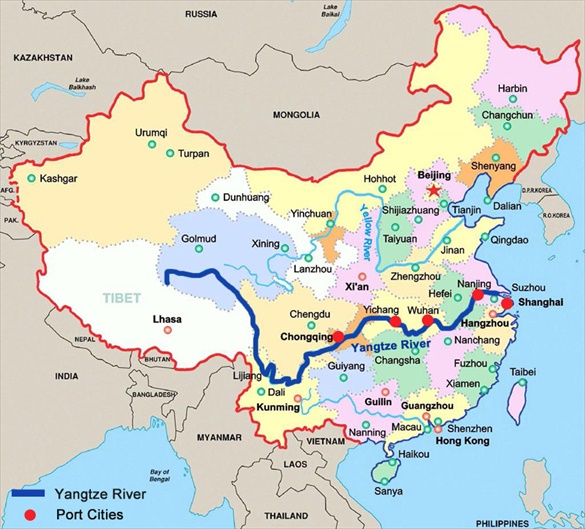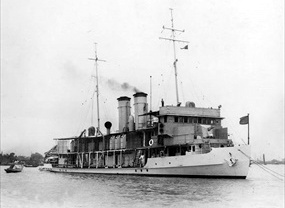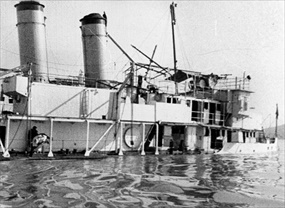DEADLY JAPANESE ATTACK ON USS PANAY
Shanghai, China • December 12, 1937
In 1937 the Chinese city of Shanghai, a city of 3 million people, dominated the country economically. Located on one of the many tributaries of the Yangtze River, Shanghai was a “treaty port” (i.e., open to foreign traders) on the East China Sea. Then as now the Yangtze River basin comprises one-fifth of the land area of China, contains nearly one-third of the national population, and is China’s agricultural motherlode. Half the country’s international trade passed through Shanghai port.
Because of Shanghai’s importance as a center of commerce, the United States, along with other major European powers, concluded treaties with local and national authorities and placed gunboats on the Yangtze River as early as the mid‑19th century. At the turn of the 20th century, expanded U.S. interests in the area prompted the U.S. to create an Asiatic Fleet to protect its trading interests in the Asia-Pacific region and establish a Yangtze River Patrol that, by the outbreak of the First World War, protected American economic and commercial interests (among them Standard Oil) from feuding Chinese warlords, bandit gangs, and pirates.
In the 1920s the U.S. commissioned and placed 6 new Chinese-built, shallow-draft gunboats on the Yangtze capable of traveling 1,300 miles/2,092 km upstream. One was the 474‑ton Panay, a 191‑ft/58‑m ship armed with 8 .30‑caliber/7.62‑mm machine guns and a pair of 3‑in/76.2‑mm deck guns fore and aft. The Panay had a crew of 5 officers and 54 enlisted men.
Following years of diplomatic and military incidents over Japan’s efforts to secure access to Chinese raw material reserves, food, and labor beginning with that country’s takeover of Manchuria in Northeast China in 1931, Japanese forces attacked Shanghai on August 13, 1937. After securing control of Shanghai, the Japanese moved up the Yangtze to Nanking (Nanjing), the capital of Nationalist Chinese leader Chiang Kai-shek; they reached the city’s outskirts on December 1. Thirteen days later the Japanese had driven the Nationalist army from Nanking. The infamous Nanking Massacre of Chinese civilians and disarmed combatants, estimated to be between 40,000 and 300,000, started that day and lasted 6 weeks.
Meanwhile, in early December 1937 the USS Panay left war-torn Shanghai for Nanking to remove the remaining Americans from the Chinese capital. Lest the U.S. gunboat be mistaken for an enemy vessel (the U.S. was neutral in the conflict), the Panay’s captain draped American flags across the boat’s upper deck; a large 6‑ by 11‑ft/1.8‑ by 3.4‑m flag flew from the boat’s mast. Docked at Nanking on December 9, the Panay took on board 8 Americans, 4 of whom were embassy staffers, and 9 others, including 2 journalists and 2 newsreel cameramen. On December 11 the Japanese began shelling near the location of the Panay, 3 Standard Oil barges flying American flags, and 2 motor sampans that were there to help Standard Oil employees and agents escape the conflict. The Panay, barges, and sampans quickly moved 7 miles upriver.
On this date, December 12, 1937, shrugging off a shakedown attempt by a Japanese naval officer wanting information about the disposition of Chinese armed forces along the river, the Panay and convoy dropped anchor 27 miles/18 km north of Nanking. The Panay’s captain contacted American authorities to alert Japanese authorities of the ships’ new location. At roughly 1:40 p.m. 3 Japanese carrier attack bombers, joined soon by a dozen-and-a-half dive bombers and fighter planes, began dropping bombs and strafing the Panay and its convoy. The unprovoked and wanton attack put the gunboat out of action, caused it to settle on the river bottom, and set 2 of the 3 oil barges ablaze. Killed on the Panay were 2 crewmen and 1 passenger. Casualties numbered 43, including 11 officers and men seriously wounded. The captain of one of the oil barges was killed as were a number of Chinese passengers before the Japanese warplanes left the scene.
USS Panay and the U.S. Navy’s Yangtze River Patrol
 |
Above: Map of China’s Yangtze River. From Shanghai the Yangtze’s watery hinterland stretches nearly 4,000 miles/6,437 km to the southwest before swinging north-northwest. In the 1840s the United States, other European powers, and, after 1895, Japan carved out extraterritorial concessions outside the walled city of Shanghai, which was still ruled by the Chinese, and floated patrol ships on the great waterway. Citizens of many countries and all continents came to Shanghai to live and work during the ensuing decades. By 1932 Shanghai had become the world’s fifth largest city, home to 70,000 foreigners, and had become the primary financial hub of the Asia-Pacific region. Only Manhattan had more skyscrapers than Shanghai. But in that same year the Japanese, supported by ships, warplanes, and 100,000 troops, used an anti-Japanese incident to expand their influence in Shanghai. In May a ceasefire agreement made the city a demilitarized zone and forbade the Chinese to garrison troops, excepting a small police force, in the city and surrounding areas while allowing the presence of a few Japanese units in the city. In August 1937 the Japanese used Shanghai as their launchpad to overthrow the Nationalist Chinese government in a protracted tug-of-war that only ended in September 1945 with Japan’s unconditional surrender to the Allies.
 |  |
Left: When the battle for Shanghai erupted in August 1937, Chiang Kai-shek’s Nationalists held out for 3 months before the Japanese forced them to abandon the city. The Nationalists eventually relocated to Chongqing (Chungking), 1,300 miles/2,092 km upriver. As the Japanese approached Nanking, the then capital of China, the U.S. Embassy evacuated the bulk of its staff aboard the USS Luzon, a slightly larger gunboat than the aging Panay. Lt. Cmdr. James J. Hughes, skipper of the smaller of the 2 gunboats, was ordered to retrieve the skeleton staff, which included the U.S. ambassador to China, remaining in Nanking, plus any American and foreign nationals who wanted to flee the city. Hughes was severely wounded in the thigh when the first Japanese bomb hit the Panay’s pilothouse on the sunny and clear afternoon of Sunday, December 12, 1937. Shortly afterwards the gunboat’s executive officer was rendered speechless by a shrapnel wound in his throat and communicated his orders to the crew in pencil on the bulkhead and navigation chart. To crew and passengers on board, it was obvious that the 2 Japanese air strikes (1 bomb run and a 20‑minute strafing attack) were deliberate: the enemy pilots were flying low enough to clearly see the American flags on the stern’s mast and lashed across the boat’s upper deck and their faces were clearly recognizable by those on the ship’s deck. Universal Newsreel cameraman Norman Alley and Fox Movietone Eric Mayell grabbed their cameras and filmed the air strikes. (See YouTube video below.)
![]()
Right: Once the survivors of the attack reached a small Chinese fishing village they raised the alarm. In the meantime, 2 boatloads of Japanese soldiers had boarded and then quickly left the sinking Panay. U.S. and British gunboats rushed to the scene, including ships and search planes from Japanese authorities who appeared shocked and confused by the incident. The release of the 2 cameramen’s film on December 19 gave the lie to the fiction that the Japanese had been targeting Chinese fleeing Nanking in troop transports. U.S. Navy intercepts of Japanese radio messages to the incoming warplanes on December 12 also showed that the attack on the Panay was intentional. Indeed, earlier that same day Japanese gun crews were reported to have opened fire on the Royal Navy gunboat HMS Ladybird, killing a sailor and wounding several others. A British merchant ship and 4 other gunboats were also fired on. Contemporary analysts and American newspapers, as well as later historians, put forth one argument that the Panay incident was most likely launched by radical elements within the Japanese military that were trying to provoke war with the U.S. Another argument was that the same radical elements saw the incident as a way of forcing the U.S. to withdraw its presence from China. President Franklin D. Roosevelt accepted Japan’s apology for the unhappy incident and the $2,214,007.36 indemnity paid to the U.S. Treasury in April 1938. Thus the matter was closed. For the moment at any rate. Then, almost 4 years later, in November 1941, naval authorities in Washington ordered all U.S. Navy vessels to leave China and proceed to the peacetime safety of the Philippines to reinforce the American presence there. The ships of the China Station were in their new Southeast Asian anchorage 2 days before Japanese warplanes dropped their deadly payloads on Pearl Harbor in Hawaii.
Rare Newsreel Footage by Universal Cameraman Norman Alley of Japanese Bombing of Nanking and USS Panay, December 1937
![]()

 History buffs, there is good news! The Daily Chronicles of World War II is now available as an ebook for $4.99 on Amazon.com. Containing a year’s worth of dated entries from this website, the ebook brings the story of this tumultuous era to life in a compelling, authoritative, and succinct manner. Featuring inventive navigation aids, the ebook enables readers to instantly move forward or backward by month and date to different dated entries. Simple and elegant! Click
History buffs, there is good news! The Daily Chronicles of World War II is now available as an ebook for $4.99 on Amazon.com. Containing a year’s worth of dated entries from this website, the ebook brings the story of this tumultuous era to life in a compelling, authoritative, and succinct manner. Featuring inventive navigation aids, the ebook enables readers to instantly move forward or backward by month and date to different dated entries. Simple and elegant! Click 











